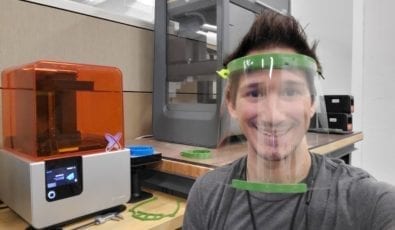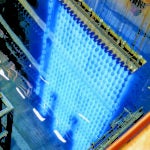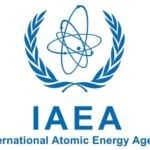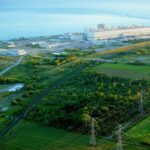Operators of the world’s nuclear reactors are doing more than keeping the lights during the coronavirus pandemic. Along with taking steps to protect their workforce, and having plans in place to keep their facilities running at a time of critical need for power, they also are using nuclear technologies to detect and fight COVID-19.
From Canada to China, from the U.S. to the Netherlands, reactor operators are continuing and expanding production of medical isotopes to sterilize medical equipment and produce solutions to battle diseases from cancer to the coronavirus. They’re also donating medical equipment and other supplies to hospitals and health-care staff on the front lines.
The field of nuclear medicine has helped the medical community for years, with practices such as imaging, using small amounts of radioactive material to diagnose, evaluate, or treat diseases from cancers to heart disease to gastrointestinal or neurological disorders. The COVID-19 pandemic is now highlighting the role the nuclear power community is playing in battling the worldwide spread of the coronavirus.
Jonathan Cobb, senior communication manager for the World Nuclear Association, told POWER on April 6 that, “For cobalt-60 and other radioisotopic sources for medical use, the emphasis is on ensuring supply of these products during the COVID-19 crisis so that they continue to be available to the medical community.” Cobalt-60, which is produced artificially in nuclear reactors, is used to sterilize medical equipment, and also used to treat cancer and some blood disorders.
Cobb noted how Bruce Power, Canada’s only private sector nuclear generator, and with 2.4-GW of generation capacity, is now focusing its attention on maintaining electricity supplies in Ontario, along with its production of cobalt-60, scaling back a major refurbishment project at the site to focus more on medical isotopes. The Major Component Replacement project at Bruce remains on schedule, but the company said activities are being narrowed to essential tasks as part of its COVID-19 response, which includes reducing the number of on-site workers by nearly 70%.
Bruce Power also on April 1 announced it will provide 600,000 pieces of personal protective equipment to support health-care workers in Ontario in their efforts against COVID-19.
Bruce Power’s eight CANDU units—CANDU stands for CANadian Deuterium Uranium—annually produce about 30% of Ontario’s power. The CANDU reactor has a unique design using natural (or lightly enriched) uranium as the fuel and heavy water (instead of light water) as a moderator. Four of Bruce’s reactors produce cobalt-60. The company produced its first medical-grade high-specific-activity cobalt-60 from Bruce Unit 7 in 2019.
The company also is part of a partnership with Isogen, a joint venture of nuclear technology giant Framatome and power sector lifecycle management service company Kinectrics. Bruce Power is Isogen’s first partner, as Isogen works to enable the use of CANDU reactors to produce medical isotopes. The development points to an expanding function for nuclear power plants beyond the production of carbon-free electricity that could furnish them with a lucrative source of revenue.
The partnership, established in July 2019, advances an innovative project that will leverage the Bruce Power facility’s scale and redundancy to produce lutetium-177, which can be used in targeted radionuclide therapy to treat cancers such as neuroendocrine tumors and prostate cancer. Lutetium-177 can destroy cancer cells while leaving healthy cells unaffected.
Mapping COVID-19 Proteins
At the ANSTO research center in Australia, the facility’s synchrotron—a cyclic particle accelerator—is being used to help determine the structure of proteins on the COVID-19 coronavirus. Many proteins in COVID 19 virus have already been mapped, and by understanding the positions of important components of these proteins, researchers can develop drugs that bind to these proteins and prevent or treat disease.
“Using our technology, within five minutes you can understand why a drug does or doesn’t work in attaching to a COVID-19 protein,” said Andrew Peele, a professor and director of the Australian Synchrotron. “We are currently receiving samples by mail to be analyzed and shared back with researchers from across Australia and Asia. By working together, utilizing all the different techniques and infrastructure at our disposal today, we can win this fight and much quicker than previous generations could have. The work is vitally important to finding a solution to combat this virus and saving lives around the world.”
The Zhongguang Nuclear Technology Development group in China, meanwhile, has donated time on its electronic beam irradiation sterilization site for the sterilization of medical supplies such as syringes, surgical sutures, gloves, and masks, saying “Controlled medical equipment provides priority and efficient anti-virus sterilization services until the epidemic situation can be controlled.”
The group’s workers also have helped the city of Wuhan, the hotspot in central China where the first case of COVID-19 was reported, to carry out disinfection efforts in the area’s hospitals, markets, communities, public toilets, and other sanitation facilities. The group in a news release said, “Now, the disinfection and sterilization progress bar in the city of Wuhan has been officially opened, and our nuclear industry personnel have been professional in sterilizing with radiation.”
3D Printing of Face Shields
Ontario Power Generation (OPG), which operates the Pickering and Darlington nuclear power stations in the province, is utilizing 3D printing technology to produce plastic face shields (Figure 1) for health-care workers. The company has partnered with Ontario Tech University in Oshawa to fast-track the production of the shields (Figure 1).
“OPG is excited to have recently received approval from Health Canada to produce these crucial shields that will help protect our frontline health-care workers when assisting patients,” said Ken Hartwick, OPG’s president & CEO, in a news release Monday. “We have a lot of innovative and passionate people on our X-Lab team and I want to thank them for thinking outside of the box in anticipation of a medical supply shortage in the province.”
OPG’s X-Lab innovation hub is now producing the headband piece used in the assembly of the face shields. The lab has secured materials for the plastic visor and adjustable elastic strap through OPG’s vendor partners.

OPG expects the first batch of 200 face shields will be ready for shipment to Ontario’s Ministry of Health on April 8. The group plans to increase production of the shields to 500 a week, and the ministry will distribute the shields to hospitals, care homes, and other essential health-care providers.
OPG previously donated 17,500 Tyvek suits to the province for frontline health-care workers. OPG uses Tyvek suits for nuclear workers, and health-care personnel can use them to protect against airborne diseases and other hazards. OPG said it had an excess inventory of suits, enabling the donation. The group also has donated 500,000 surgical masks and 75,000 N95 masks to the province’s hospitals and health-care facilities.
Medical Supplies and Different Isotopes
Other nuclear power reactors worldwide are taking steps to protect their workers and communities. The World Nuclear Association is summarizing many of these actions in a daily update regarding the coronavirus and nuclear energy. The International Atomic Energy Agency (IAEA) on April 2 said it is dispatching a first batch of equipment to more than 40 countries, designed to enable a nuclear-derived technique to rapidly detect the coronavirus that causes COVID-19.
NRG, a Netherlands-based internationally operating nuclear service provider, has regularly produced isotopes. NRG, through its Petten nuclear research reactors in Petten, Netherlands, produces several isotopes for medical applications, including molybdenum technetium, which is used exclusively for diagnostics. Other medical isotopes produced by NRG include lutetium-177, iridium-192, and strontium-89.
NRG in specifically addressing the coronavirus has said: “Our social role for the 30,000 patients who are helped daily with the medical isotopes from Petten is of enormous importance. We will make every effort to continue to provide this. We are discussing this with all partners throughout the production chain. We also try to continue our nuclear services in other sectors as well as possible. We are confident that we will work this out together. Take care of yourself and each other!”
—Darrell Proctor is associate editor for POWER (@DarrellProctor1, @POWERmagazine). Senior associate editor Sonal Patel contributed to this report (@Sonalcpatel).










